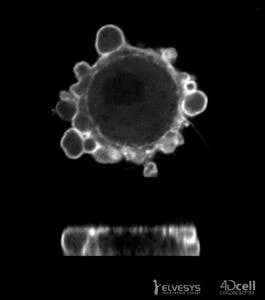Microfluidic cell confiner for next-generation cell culture systems: MicroMechCell
Cell culture systems do not reflect in vivo conditions. Although these systems are effective, they don’t consider the surrounding cells.
This project is completed now. If interested, feel free to contact us.
Cell confiner: introduction

Cells are typically cultured on flat surfaces in petri dishes or flasks. Although these systems are very effective, they ignore the reality that cells in the body are surrounded by other cells and extracellular matrix and are constantly subjected to forces.
Specific cells experience additional types of strain: muscle, heart, and lung cells are under various types of repetitive strain, and the tumor environment is subjected to increased pressure. Our cell confiner should solve this problem.
A system that is easy to use for cell culture under confinement is not yet commercially available, and a market study demonstrates that it can be helpful for researchers or industrials. Therefore, creating an easy-to-use tool to confine cells with micrometer precision is a plus.
The cell confiner device allows confining of cells within two surfaces with micrometer precision. The space between the two surfaces is controlled by using micro polydimethylsiloxane (PDMS) pillars.
The micropillars are fabricated in the top confining surface, a glass slide. The glass slide is attached to a PDMS structure that acts as a piston. This piston is controlled with a vacuum pump, and the height of the confinement is thus controlled as well. The device can be used in a Petri dish, in a glass substrate, etc.
The device has a second version that allows confining cells in a multi-well plate. In this one, the vacuum pump is unnecessary since the pressure system is based on a modified lid containing PDMS blocks with confinement slides on the extremity.
Cell confiner: applications
To study cell dynamics triggered by /under mechanical effects:
- Migration
- Cell division
- Induced autophagy
- Mechanotransduction
- Mechanics of the nucleus
- Etc.
To co-culture cells
- Use with special substrates – functionalized, micro patterned, etc.
- Mimicking the natural cell environment
- Imaging
- Cell counting
The technology to confine the cells is already available and validated (Le Berre et al., Int. Bio. 2012). However, the MicroMechCell project aims to make the device viable for commercialization through the development of a more reliable system.
Explore the potential of the confiner with 4Dcell!
This project has received funding from the European Union’s Horizon 2020 research and innovation program under grant agreement No 739692 (MICROMECHCELL project).
DISCLAIMER: The results reflect only the author’s point of view, and the EASME (Executive Agency for Small and Medium-sized Enterprises) is not responsible for any use that may be made of the information it contains.

